The CUET PG 2024 Hindu Studies 27th March 2024 Shift 1 Question Paper with Solution PDF is available for download here. Students found the Vedic Literature and Philosophy section easy, Classical Hindu Texts moderate, and Comparative Religious Studies difficult. The Comparative Religious Studies section carried the highest weightage, and the overall difficulty level was moderate to difficult.
CUET PG 2024 Hindu Studies Question Paper with Answer Key PDF
| CUET PG 2024 Hindu Studies Question Paper with Answer Key | Check Solution |


Question 1:
Kauthum Shakha is associated with which Veda?
View Solution
The Kauthum Shakha is one of the prominent branches of the Samaveda. The Samaveda is known as the Veda of melodies and chants, and it forms a crucial part of the Vedic traditions in Indian culture. The Kauthum Shakha specifically deals with the arrangement and recitation of the Samaveda hymns. It is widely followed in several parts of India. Quick Tip: The Samaveda is often called the "Veda of Music" as it includes chants that are meant to be sung during rituals. The Kauthum Shakha is one of its most significant traditions.
Rigveda is divided into:
View Solution
The Rigveda, one of the oldest and most significant Vedic texts, is divided into eight sections known as Ashtaks. Each \textit{Ashtak is further subdivided into chapters and hymns. This division facilitates systematic study and recitation. The \textit{Ashtak system provides a structured framework for preserving and transmitting the text across generations. Quick Tip: The term \textit{Ashtak is derived from the Sanskrit word meaning "eight," reflecting the Rigveda's division into eight parts for ease of recitation and study.
Most of the Suktas in Rigveda are related to:
1. Indra
View Solution
The Rigveda, a foundational text of Indian civilization, contains numerous \textit{Suktas (hymns) dedicated to various deities. Among these, the majority are devoted to Indra, the king of gods and the deity of rain and thunderstorms. Indra is celebrated for his heroic deeds, such as defeating the demon \textit{Vritra and liberating the waters, which symbolize prosperity and fertility. Quick Tip: Indra is the most frequently mentioned deity in the Rigveda, symbolizing strength, courage, and victory over obstacles.
It is not counted in Vedatrayee:
View Solution
The term Vedatrayee refers to the three primary Vedas—\textit{Rigveda, \textit{Yajurveda, and \textit{Samveda. These are considered the core texts for Vedic rituals and practices. The \textit{Atharvaveda, though equally significant, is not included in \textit{Vedatrayee because it primarily deals with knowledge related to everyday life, healing, and practical matters rather than rituals and sacrifices. Quick Tip: The \textit{Atharvaveda focuses on practical knowledge, such as medicine and charms, distinguishing it from the ritual-oriented Vedatrayee.
Ishopanishad is related to which Veda?
View Solution
The Ishopanishad, one of the principal Upanishads, is part of the \textit{Yajurveda. It is a philosophical text that explores the nature of the self, the ultimate reality (\textit{Brahman), and the relationship between the two. The teachings emphasize the importance of living a balanced life that combines material prosperity with spiritual awareness, offering guidance on achieving liberation (\textit{moksha). Quick Tip: The \textit{Ishopanishad derives its name from the opening word Isha (meaning "Lord"), emphasizing the omnipresence of the divine in all aspects of existence.
Satyamev Jayate is a saying of which Upanishad?
View Solution
The phrase Satyamev Jayate (Truth Alone Triumphs) originates from the \textit{Mundakopanishad, which is part of the \textit{Atharvaveda. It appears in Chapter 3, Section 1, Verse 6.The complete verse conveys the idea that truth leads to the divine path, enabling one to achieve liberation (\textit{moksha) and realize the ultimate reality (\textit{Brahman).
\textit{Satyamev Jayate is also the national motto of India, symbolizing the nation's commitment to truth and justice. Quick Tip: \textit{Satyamev Jayate is inscribed on the Indian national emblem and represents the core value of truth as a guiding principle for governance and morality.
Udgata is the Ritvik of which Veda?
View Solution
The term Udgata refers to the priest associated with the recitation and singing of hymns from the \textit{Samveda. The \textit{Udgata specializes in chanting \textit{Saman, which are melodic renditions of the \textit{Rigvedic hymns. The role of the \textit{Udgata is integral during the performance of \textit{Yajnas (sacrificial rituals), where the hymns are sung in specific meters to invoke the divine. Quick Tip: The \textit{Samveda is known as the Veda of melodies and chants, and its primary focus is on music and its application in rituals.
How many varnas are there in Hindu culture?
View Solution
In Hindu culture, the society was traditionally divided into four Varnas or classes. These are:
% Option
(A) Brahmins: Priests and scholars responsible for spiritual education and rituals.
% Option
(B) Kshatriyas: Warriors and rulers responsible for protection and governance.
% Option
(C) Vaishyas: Merchants and agriculturists responsible for trade and economic activities.
% Option
(D) Shudras: Laborers and service providers who supported the other three \textit{Varnas.
This classification is described in ancient texts such as the \textit{Manusmriti and the \textit{Bhagavad Gita. Quick Tip: The concept of \textit{Varna in Hinduism was initially based on duties (Dharma) rather than birth, emphasizing social and occupational roles.
Where is the oldest mention of the Varna system found?
View Solution
The oldest mention of the Varna system is found in the \textit{Rigveda, specifically in the Purusha Sukta (Rigveda 10.90). This hymn describes the cosmic being (\textit{Purusha) and explains the origin of the four \textit{Varnas:
Brahmins emerged from the \textit{Purusha's mouth.
Kshatriyas came from the arms.
Vaishyas originated from the thighs.
Shudras came from the feet.
This metaphor illustrates the division of society into different roles based on function and responsibility. Quick Tip: The \textit{Purusha Sukta of the Rigveda is a key source for understanding the ancient classification of society into Varnas.
Sannyaasa is a kind of:
View Solution
Sannyaasa is the fourth and final stage (Ashram) in the traditional Hindu \textit{Ashrama system. It is the stage of renunciation, where an individual renounces worldly possessions, desires, and responsibilities to focus on spiritual growth and liberation (\textit{Moksha). The four \textit{Ashramas in Hindu culture are:
Brahmacharya: The stage of learning and discipline.
Grihastha: The householder stage.
Vanaprastha: The stage of partial retirement.
Sannyaasa: The stage of complete renunciation.
Sannyaasa marks the culmination of an individual’s spiritual journey, aiming for self-realization and freedom from the cycle of birth and death (\textit{Samsara). Quick Tip: The \textit{Ashrama system is a framework for organizing an individual's life into phases, each with specific duties and spiritual goals.
How many Ashramas are there?
View Solution
In Hindu philosophy, life is divided into four stages called Ashramas, which represent different phases of life and their associated duties and responsibilities:
Brahmacharya: The stage of learning and celibacy.
Grihastha: The householder stage focused on family and societal duties.
Vanaprastha: The stage of gradual detachment from worldly life and preparation for renunciation.
Sannyaasa: The final stage of renunciation, focusing entirely on spiritual goals and liberation (\textit{Moksha).
These four stages are designed to guide individuals through a balanced and spiritually fulfilling life. Quick Tip: The \textit{Ashrama system provides a framework for integrating worldly responsibilities with spiritual growth across the stages of life.
How many Kandas are there in Valmiki Ramayana?
View Solution
The Valmiki Ramayana, one of the two great epics of India, is divided into seven sections known as Kandas. Each \textit{Kanda represents a distinct phase in the story of Lord Rama:
Bala Kanda: Describes the childhood of Rama and his brothers.
Ayodhya Kanda: Covers Rama's exile from Ayodhya.
Aranya Kanda: Chronicles Rama's life in the forest and Sita's abduction.
Kishkindha Kanda: Focuses on Rama's alliance with Hanuman and Sugriva.
Sundara Kanda: Narrates Hanuman's journey to Lanka to locate Sita.
Yuddha Kanda: Details the battle between Rama and Ravana.
Uttara Kanda: Discusses the later years of Rama's reign.
These seven \textit{Kandas encapsulate the moral and spiritual lessons of the epic. Quick Tip: The seven \textit{Kandas of the Ramayana illustrate the journey of virtue, devotion, and the triumph of good over evil.
Ramayana is called?
View Solution
The Ramayana, authored by Sage Valmiki, is referred to as the Adikaavya (the first epic) of Indian literature. It is considered the first poetic composition in Sanskrit and is highly revered for its literary, cultural, and philosophical significance. The term \textit{Adikaavya reflects its pioneering role in shaping the epic poetry tradition of India. Quick Tip: The title \textbf{Adikaavya signifies that the Ramayana is the earliest and most foundational epic in Indian literature.
This is the fifth Kanda of Ramayana:
View Solution
The Sunderkand is the fifth \textit{Kanda (book) of the \textit{Ramayana. It primarily focuses on Lord Hanuman's journey to Lanka in search of Sita and showcases his unparalleled devotion, courage, and wisdom. The name "Sunderkand" translates to the "beautiful episode," emphasizing the virtues of valor, intelligence, and devotion highlighted in this part of the epic. Quick Tip: The \textbf{\textit{Sunderkand} is often recited for spiritual benefits and is celebrated for its inspiring portrayal of Hanuman's devotion and heroism.
Mricchakatikam is written by:
View Solution
The Mricchakatikam (The Little Clay Cart) is a classical Sanskrit drama attributed to the playwright Shoodrak. It is a ten-act play that vividly depicts themes of love, social class, and political intrigue. The story primarily revolves around the romance between Charudatta, a poor Brahmin, and Vasantasena, a courtesan, against the backdrop of societal and political challenges. Quick Tip: \textit{Mricchakatikam is unique for its realistic portrayal of everyday life and its focus on human emotions, making it a masterpiece of ancient Indian drama.
How many verses are there in Mahabharata?
View Solution
The \textit{Mahabharata is one of the greatest epics of ancient India and is attributed to the sage Vyasa. It is known for its vastness and comprehensiveness, containing approximately 1,00,000 verses. This makes it one of the longest epic poems in the world. The work is divided into 18 parvas (books) and includes numerous sub-stories and philosophical discussions, including the revered \textit{Bhagavad Gita. Quick Tip: The Mahabharata's length and scope are unparalleled, offering a blend of history, mythology, and moral philosophy.
Mahabharat is written by
View Solution
The \textit{Mahabharata, one of the greatest epics in Indian literature, was composed by the sage Vedavyasa. He is also known as Vyasa or Krishna Dvaipayana. Vedavyasa is credited with compiling and organizing the Vedas and writing other significant texts like the \textit{Puranas. The Mahabharata contains profound philosophical and moral teachings, including the celebrated \textit{Bhagavad Gita. Quick Tip: Vedavyasa is regarded as one of the seven Chiranjivi (immortals) in Hindu mythology and is celebrated for his unparalleled contribution to Indian scriptures.
How many chapters are there in Bhagavadgeeta?
View Solution
N/A
What is the name of 3rd Chapter of the Bhagavadgeeta?
View Solution
The 3rd chapter of the Bhagavad Gita is named Karmayoga or the Yoga of Action. In this chapter, Lord Krishna emphasizes the importance of performing one's duty selflessly and without attachment to the results. He explains that action performed in a spirit of devotion and without selfish desires leads to liberation. Krishna also advocates the concept of \textit{Nishkama Karma (desireless action) as a path to spiritual growth and harmony. Quick Tip: Karmayoga teaches that by focusing on the action and surrendering the fruits to a higher power, one can attain spiritual fulfillment and avoid the bondage of karma.
Lokayata Darshana is another name of which philosophy?
View Solution
Lokayata Darshana is another name for Charvak Darshana, an ancient Indian materialistic and atheistic philosophy. Charvak philosophy is known for its rejection of the Vedas, metaphysical concepts, and the notion of an afterlife. It emphasizes that direct perception (\textit{pratyaksha) is the only valid means of knowledge and advocates materialism and hedonism. According to this philosophy, the primary goal of life is to seek happiness and avoid pain, as there is no existence beyond the physical world. Quick Tip: Charvak philosophy challenges spiritual and religious dogmas, promoting rationalism and empirical evidence as the basis for truth.
How many Pramanas are there in Nyaya Darshana?
View Solution
Nyaya Darshana recognizes four Pramanas (means of valid knowledge), which are:
% Option
(A) Pratyaksha (Perception): Knowledge acquired through direct sensory perception.
% Option
(B) Anumana (Inference): Knowledge gained through logical reasoning and deduction.
% Option
(C) Upamana (Comparison): Knowledge derived through analogy or comparison.
% Option
(D) Shabda (Verbal Testimony): Knowledge obtained through reliable verbal or scriptural testimony.
These Pramanas serve as the basis for epistemology in the Nyaya system of Indian philosophy. Quick Tip: Nyaya Darshana emphasizes logical reasoning and critical thinking, making it one of the foundational systems of Indian philosophy.
The name of the twenty-fourth Tirthankara in Jainism is
View Solution
N/A
Acharya Kapil is the Pravartak (originator) of which philosophy?
View Solution
Acharya Kapil is regarded as the founder of Sankhya Darshan, one of the six classical systems of Indian philosophy. Sankhya philosophy is dualistic and focuses on the distinction between Purusha (consciousness) and Prakriti (matter). It provides a theoretical foundation for Yoga and is one of the oldest philosophical systems in India. Quick Tip: Sankhya Darshan emphasizes self-realization through the understanding of the separation between Purusha and Prakriti.
How many substances are there in Vaisheshika Philosophy ?
View Solution
In this philosophy, there are four types of substances referring to the fundamental categories considered essential for understanding reality. These are earth (prithvi), water (ap), fire (tejas), and air (vayu).
The focus here is on physical elements that constitute the material world in their philosophy.
These types reflect the diverse societal norms and practices in ancient Hindu traditions. Quick Tip: In Hindu culture, Brahma Vivaha is considered the most ideal form of marriage, emphasizing sanctity and societal norms.
How many types of marriage are there in Hindu culture?
View Solution
In Hindu culture, there are eight types of marriages mentioned in ancient scriptures like Manusmriti. These are:
(A) Brahma Vivaha: Marriage arranged by the family, considered the most sacred and ideal form.
(B) Daiva Vivaha: Marriage where the bride is given to a priest during a religious sacrifice.
(C) Arsha Vivaha: Marriage in which the groom gives cattle or wealth to the bride's father.
(D) Prajapatya Vivaha: Marriage emphasizing duty and equality between partners.
(E) Gandharva Vivaha: Marriage based on mutual love and consent.
(F) Asura Vivaha: Marriage involving wealth or gifts given to the bride's family, often criticized.
(G) Rakshasa Vivaha: Marriage by abduction, considered a form of forced marriage.
(H) Paishacha Vivaha: Marriage involving deceit or exploitation, considered the least ideal.
These types reflect the diverse societal norms and practices in ancient Hindu traditions. Quick Tip: In Hindu culture, Brahma Vivaha is considered the most ideal form of marriage, emphasizing sanctity and societal norms.
Annaprashan is a
View Solution
Annaprashan is one of the sixteen Sanskaaras (rites of passage) in Hindu culture. It is a ceremonial first feeding of solid food to an infant. Typically performed between the sixth to eighth month after birth, this ritual signifies the transition of the child to a diet beyond milk and symbolizes physical and spiritual growth. Quick Tip: Annaprashan is a key milestone in a child’s life, symbolizing their first introduction to solid food and marking their growth.
Which is the ritual performed for education?
View Solution
Upanayana is a sacred Hindu ritual that marks the initiation of a student into education and learning, particularly in Vedic studies. It involves the wearing of the sacred thread (\textit{Yajnopavita) and symbolizes the start of formal education under the guidance of a guru. This ritual signifies the transition of the child into the \textit{Brahmacharya Ashram and their commitment to learning and discipline. Quick Tip: The Upanayana ceremony is a significant milestone in a child’s life, marking their readiness to undertake education and spiritual practices.
How many Jyotirlingas are there in India?
View Solution
N/A
Sarga, Pratisarga, Vansh, Manvantar is the definition of:
View Solution
The terms Sarga (creation), Pratisarga (secondary creation or dissolution), Vansh (genealogy of gods and sages), and Manvantar (epochs of Manu) collectively define the structure of a Purana. Puranas are ancient Hindu texts that contain narratives of the history of the universe, the genealogies of kings, heroes, and demigods, as well as cosmology and mythology. They are regarded as a vital part of Vedic literature. Quick Tip: The Puranas are traditionally classified into 18 Mahapuranas and 18 Upapuranas, and they serve as a comprehensive guide to Hindu culture, philosophy, and traditions.
Who is the writer of Puranas?
View Solution
The Puranas are traditionally attributed to Vedavyas, also known as Veda Vyasa. He is regarded as a sage who compiled and divided the Vedas and authored the Mahabharata. The Puranas consist of mythological stories, genealogies, cosmology, and teachings that are integral to Hindu culture and philosophy. Quick Tip: Vyasa is considered one of the seven immortals (Chiranjivi) in Hindu tradition and holds a pivotal role in organizing and preserving the Vedic knowledge.
Samaavartan is a
View Solution
Samaavartan is one of the sixteen Sanskaars in Hindu tradition. It marks the completion of formal education (Brahmacharya Ashram) and the student's return home from the Gurukul. This ritual symbolizes the readiness of an individual to take up responsibilities in worldly life, particularly the Grihastha Ashram. Quick Tip: Samaavartan is also known as the "graduation ceremony" in the Vedic education system, signifying the end of Vedic learning.
What are Vedic hymns called?
View Solution
Vedic hymns are called Mantras. They are sacred chants or verses found in the Vedas, which are the oldest texts of Hindu philosophy and spirituality. These Mantras are composed in Vedic Sanskrit and are used in rituals, prayers, and meditative practices to invoke divine blessings and maintain cosmic order. Quick Tip: Mantras are classified into three types: Rigvedic (hymns of praise), Yajurvedic (sacrificial formulas), and Samavedic (musical chants).
Who is the Nayak (Hero) of Ramayana?
View Solution
The Nayak (hero) of the epic Ramayana is Lord Ram. He is depicted as the ideal man and king, known for his virtues, righteousness, and devotion to dharma. The Ramayana, written by Valmiki, narrates the story of Ram's life, including his exile, the abduction of his wife Sita by Ravana, and his victory over the demon king. Quick Tip: Lord Ram is also referred to as \textbf{Maryada Purushottam}, symbolizing the epitome of morality and ideal conduct.
Who is the Originator of Buddhist Philosophy?
View Solution
The originator of Buddhist Philosophy is Gautam Buddha, also known as Siddhartha Gautama. He founded Buddhism in the 5th–4th century BCE. His teachings, often called the Dharma, focus on the Four Noble Truths and the Eightfold Path, which aim to end suffering and attain enlightenment (Nirvana). Buddhism emphasizes non-violence, self-discipline, and the cultivation of wisdom and compassion. Quick Tip: Buddhism spread widely across Asia and has influenced diverse cultures and philosophies. Gautam Buddha's insights are foundational for this spiritual tradition.
Who is the Originator of Vedanta Philosophy?
View Solution
The originator of Vedanta Philosophy is Badarayan, also known as Vyasa. He is credited with composing the Brahma Sutras (Vedanta Sutras), which systematize the philosophical teachings of the Upanishads. Vedanta, meaning "end of the Vedas," focuses on the ultimate nature of reality (Brahman) and the liberation of the soul (Moksha). While Shankaracharya later provided significant interpretations, the foundational text was authored by Badarayan. Quick Tip: Vedanta Philosophy emphasizes the unity of the individual soul (Atman) and the universal reality (Brahman), forming the basis of much of Indian spiritual thought.
Birth Date of Bhagwan Shrikrishna is:
View Solution
Bhagwan Shrikrishna was born on Bhadrapada Krishna Ashtami, which is celebrated as Janmashtami. This date falls on the eighth day (Ashtami) of the Krishna Paksha (waning phase of the moon) in the month of Bhadrapada according to the Hindu calendar. Shrikrishna's birth is considered auspicious and marks the arrival of the eighth avatar of Vishnu, symbolizing the victory of good over evil. Quick Tip: Janmashtami is observed with great devotion and enthusiasm across India and involves fasting, singing devotional songs, and reenactments of Krishna's childhood stories.
The number of famous Dhaams in Hindu religion is:
View Solution
In Hindu religion, there are four famous Dhaams, collectively known as the Char Dham. These include:
Badrinath (in Uttarakhand, dedicated to Vishnu)
Dwarka (in Gujarat, dedicated to Krishna)
Puri (in Odisha, dedicated to Jagannath)
Rameshwaram (in Tamil Nadu, dedicated to Shiva)
The Char Dham pilgrimage holds great spiritual significance and is believed to cleanse one of all sins, leading to moksha (liberation). Quick Tip: The Char Dham was established by the great philosopher and reformer \textbf{Adi Shankaracharya} to unite the Hindu religion and culture.
The oldest book is:
View Solution
N/A
Who is the writer of the Mimamsasutra?
View Solution
The Mimamsasutra was written by the sage Jaimini. This foundational text forms the basis of the Purva Mimamsa philosophy, which emphasizes the ritualistic aspects of the Vedas. Jaimini's work provides a detailed exposition of dharma (duty) as interpreted through the Vedic texts, focusing on the performance of Vedic sacrifices and the principles underlying them. Quick Tip: \textbf{Jaimini's Mimamsasutra serves as the philosophical groundwork for the Purva Mimamsa school, emphasizing the authority of the Vedas in guiding human actions.
How many elements (Tatva) are in Yogadarshan?
View Solution
N/A
What is the first Sutra of Brahmasutra?
View Solution
The first Sutra of the Brahmasutra, composed by Badarayana, is "Athato Brahmajijnasa". This translates to "Now, therefore, the inquiry into Brahman." It signifies the beginning of a philosophical quest to understand Brahman, the ultimate reality, after preparing oneself with the necessary qualifications, such as ethical discipline and spiritual maturity. Quick Tip: \textit{Brahmasutra begins with "Athato Brahmajijnasa," emphasizing the importance of systematic inquiry into the nature of the ultimate reality, Brahman.
'Mayapuri' is the name of which religious city?
View Solution
Haridwar is referred to as "Mayapuri" in Hindu religious texts. It is one of the seven holiest places (Sapta Puri) in India and is located at the foothills of the Himalayas where the Ganga River enters the plains. Haridwar holds immense spiritual significance and is a major pilgrimage site, known for hosting the Kumbh Mela and for its ghats like Har Ki Pauri. Quick Tip: Haridwar, also known as "Mayapuri," is a sacred city where pilgrims gather for rituals and ceremonies, especially along the Ganga River.
Religious place not situated at the banks of Ganga:
View Solution
Ujjayini, also known as Ujjain, is not located on the banks of the Ganga River. It is situated on the banks of the Kshipra River in Madhya Pradesh. Ujjayini is a significant religious and historical city, known for the Mahakaleshwar Jyotirlinga, one of the twelve Jyotirlingas dedicated to Lord Shiva. The other options—Rishikesh, Kashi (Varanasi), and Haridwar—are all located along the Ganga River and hold immense spiritual significance in Hinduism. Quick Tip: Ujjayini is associated with the Kshipra River, not the Ganga, and is a prominent site for the Kumbh Mela.
Whose daughter is Yamuna?
View Solution
Yamuna is regarded as the daughter of Surya, the Sun God, in Hindu mythology. She is also the sister of Yama, the god of death, and is often referred to as Yami in ancient texts. Yamuna holds significant spiritual importance and is worshipped as a sacred river goddess, symbolizing purity and divinity. Quick Tip: Yamuna, the river goddess, is the daughter of Surya and has a strong association with purity and spiritual significance in Hinduism.
Who is called 'Devaraj'?
View Solution
Indra, the king of gods, is referred to as 'Devaraj' in Hindu mythology. He rules over Svarga (heaven) and presides over the Devas (gods). Indra is associated with thunder, rain, and lightning, and is often depicted wielding a thunderbolt weapon called Vajra. He is also celebrated as a protector and a warrior who defends the heavens from demons. Quick Tip: Indra, as the 'Devaraj,' symbolizes authority, power, and the ruler of the celestial realm in Vedic and Puranic traditions.
It is not included in Ashrama
A. Brahmacharya
B. Shudra
C. Grihastha
D. Upanayan
Choose the correct answer from the options given below:
View Solution
In the traditional Hindu system, Ashramas refer to the four stages of life—Brahmacharya (student life), Grihastha (householder life), Vanaprastha (retirement), and Sannyasa (renunciation).
Shudra, being a Varna (caste), and Upanayan, being a Samskara (ritual), are not considered part of the Ashrama system. Therefore, they are excluded from the Ashramas. Quick Tip: Ashramas are stages of life, not related to caste (Varna) or rituals (Samskara).
These are not statements of Bhagavadgeeta
A. Yogah karmasu kaushalam
B. Yogashchittivrittinirodhah
C. Samatvam yog uchyate
D. Yogah samadhih
Choose the correct answer from the options given below:
View Solution
A. Yogah karmasu kaushalam (Skill in action is yoga) and C. Samatvam yog uchyate (Equanimity is yoga) are famous teachings from the Bhagavadgeeta.
B. Yogashchittivrittinirodhah (Yoga is the cessation of mental fluctuations) is from the \textit{Yoga Sutras of Patanjali, and D. Yogah samadhih (Yoga is a state of absorption) is also from texts outside the Bhagavadgeeta.
Hence, statements B and D are not from the Bhagavadgeeta. Quick Tip: Familiarity with texts like the Bhagavadgeeta and Yoga Sutras helps in distinguishing philosophical concepts and their sources.
Sects (Sampradayas) of Buddhist philosophy are
A. Udaseen
B. Vaibhashik
C. Sautrantik
D. Nakuleesh
Choose the correct answer from the options given below:
View Solution
The Buddhist philosophy developed into various sects over time. Two of the significant sects are:
Vaibhashik: Known for emphasizing detailed commentaries and interpretations.
Sautrantik: Focused on the teachings of the Buddha as found in the sutras, rather than later commentaries.
Udaseen and Nakuleesh are not sects of Buddhist philosophy. Udaseen refers to a detached or indifferent attitude, and Nakuleesh is associated with Shaivism, not Buddhism. Quick Tip: Buddhist sects like Vaibhashik and Sautrantik are rooted in specific interpretations of the Buddha's teachings, highlighting philosophical diversity within Buddhism.
Sects of Jain Philosophy are
A. Pitambara
B. Digambara
C. Raktambara
D. Shwetambara
Choose the correct answer from the options given below:
View Solution
The two major sects of Jain philosophy are:
Digambara: This sect believes in complete renunciation, including the practice of nudity, symbolizing the rejection of material possessions.
Shwetambara: Followers of this sect wear simple white clothes, symbolizing purity.
Pitambara and Raktambara are not associated with Jain philosophy. The names might signify colors or practices in other contexts but do not pertain to Jain sects. Quick Tip: Jain philosophy's two main sects, Digambara and Shwetambara, differ in their interpretations of Jain teachings and practices.
Are related to Nyayadarshana
A. Maharshi Gautama
B. Ashtavakra
C. Ishwarakrishna
D. Gangeshopadhyaya
Choose the correct answer from the options given below:
View Solution
Nyayadarshana, one of the six classical schools of Indian philosophy, emphasizes logical reasoning and debate to establish philosophical truths.
Maharshi Gautama: The founder of Nyayadarshana, he authored the foundational text called the "Nyayasutras."
Gangeshopadhyaya: A significant scholar of the Nyaya school, he contributed to its development with his works such as "Tattva Chintamani."
Ashtavakra is associated with Advaita Vedanta, and Ishwarakrishna is the commentator of Sankhya Darshana, not Nyayadarshana. Quick Tip: Nyayadarshana is deeply rooted in logical debate and reasoning, with Maharshi Gautama and Gangeshopadhyaya being prominent contributors.
According to Nyaya Darshana, these are not counted in Panchaavayava-
A. Udaharan
B. Anumiti
C. Vyaptismaran
D. Pratijna
Choose the correct answer from the options given below:
View Solution
According to Nyaya Darshana, Panchaavayava includes five elements:
- Pratijna (D), which is a statement or assertion.
- Udaharan (A), which is counted as an example.
- Vyaptismaran (C) is not counted as one of the Panchaavayava.
Anumiti (B) and Vyaptismaran (C) are counted among the five logical steps, as they are often used as part of reasoning but are not considered one of the Panchaavayava. Quick Tip: In Nyaya Darshana, the five logical steps of inference do not include B and C, which are used in reasoning but not considered formal components of Panchaavayava.
Two major elements (Tattva) of Sankhya Darshan are
A. Prakriti
B. Purusha
C. Parmanu
D. Pramaan
Choose the correct answer from the options given below:
View Solution
Sankhya Darshan, one of the six classical schools of Indian philosophy, is centered on two fundamental principles:
Prakriti: The unmanifested, primordial matter that is the source of all material creation.
Purusha: The passive observer or pure consciousness, which is independent of Prakriti but interacts with it to manifest the universe.
The other options, Parmanu (atoms) and Pramaan (means of valid knowledge), are not considered fundamental elements of Sankhya philosophy. Quick Tip: Sankhya Darshan explains the creation and existence of the universe through the dual principles of Prakriti (matter) and Purusha (consciousness).
These are written by Ramanujacharya
A. Vedarthasangraha
B. Shribhashya
C. Siddhitraya
D. Vedantaparibhasha
Choose the correct answer from the options given below:
View Solution
Ramanujacharya, a prominent philosopher and theologian of the Vishishtadvaita (qualified non-dualism) school of Vedanta, authored the following:
Vedarthasangraha: A critical summary of the teachings of the Upanishads.
Shribhashya: A detailed commentary on the Brahmasutras, establishing the principles of Vishishtadvaita Vedanta.
The other works mentioned, Siddhitraya and Vedantaparibhasha, are not authored by Ramanujacharya but by other scholars. Quick Tip: Ramanujacharya's works, such as Vedarthasangraha and Shribhashya, form the foundation of the Vishishtadvaita philosophy.
These are the Famous Acharyas of Nath Sampradaya (Sect)-
A. Gorakshanatha
B. Ramnatha
C. Jagannatha
D. Matsyendranatha
Choose the correct answer from the options given below:
View Solution
The famous Acharyas of the Nath Sampradaya sect include:
- Gorakshanatha (A) as prominent leader and saint.
- Matsyendranatha (D) is also associated with the sect
but Jagannatha (C) is not traditionally one of the core Acharyas.
Quick Tip: Gorakshanatha and Matsyendranatha are often regarded as the key figures in the Nath Sampradaya sect, while Ramnatha is also highly revered.
Famous Plays (Natak) of Kalidasa are
A. Uttararamcharita
B. Abhijnanshakuntala
C. Pratimanataka
D. Malvikagnimitra
Choose the correct answer from the options given below:
View Solution
Kalidasa, a renowned classical Sanskrit poet and playwright, authored the following famous plays:
Abhijnanshakuntala: A masterpiece that narrates the love story of King Dushyanta and Shakuntala.
Malvikagnimitra: A romantic play about King Agnimitra and the maiden Malavika.
The other options, Uttararamcharita and Pratimanataka, are not works of Kalidasa. They belong to other playwrights. Quick Tip: Kalidasa's plays are celebrated for their poetic excellence and profound portrayal of emotions, especially in Abhijnanshakuntala and Malvikagnimitra.
Match List I with List II
LIST I & & LIST II
A. & Rigveda & I. & Udgataa
B. & Yajurveda & II. & Brahma
C. & Samveda & III. & Hota
D. & Atharvaveda & IV. & Adhvaryu
Choose the correct answer from the options given below:
View Solution
In the Vedic tradition, each Veda is associated with a specific Ritvik role:
Rigveda: The Hota is responsible for recitation of hymns and mantras.
Yajurveda: The Adhwaryu performs the practical aspects of rituals.
Samveda: The Udgaataa chants melodies and hymns.
Atharvaveda: The Brahma oversees the ritual, ensuring its correctness. Quick Tip: Each Veda corresponds to a specific role in the Vedic rituals, emphasizing their unique contributions to the ceremonies.
Match List I with List II
LIST I & & LIST II
A. & Jain & I. & Satkaaryavaad
B. & Charvaak & II. & Syaadvaad
C. & Buddhist & III. & Sukhvaad
D. & Sankhya & IV. & Kshanikavaad
Choose the correct answer from the options given below:
View Solution
- Jain philosophy is associated with Syaadvaad (doctrine of conditional predication).
- Charvaak philosophy is associated with Sukhvaad (doctrine of material pleasure).
- Buddhist philosophy is associated with Kshanikavaad (doctrine of momentariness).
- Sankhya philosophy is associated with Satkaaryavaad (doctrine of causation).
Quick Tip: These philosophical doctrines reflect diverse interpretations of reality in Indian traditions.
Match List I with List II
LIST I & & LIST II
A. & Rigveda & I. & Chhandogyopanishad
B. & Yajurveda & II. & Mundakopanishad
C. & Samveda & III. & Aitareyopanishad
D. & Atharvaveda & IV. & Ishopanishad
Choose the correct answer from the options given below:
View Solution
- Rigveda is associated with Aitareyopanishad.
- Yajurveda is associated with Ishopanishad.
- Samveda is associated with Chhandogyopanishad.
- Atharvaveda is associated with Mundakopanishad.
Quick Tip: Each Upanishad is linked to a specific Veda and contains philosophical teachings central to Hindu thought.
Match List I with List II
LIST I & & LIST II
A. & Varna & I. & Upanayan
B. & Sanskara & II. & Dharma
C. & Purushaartha & III. & Brahmana
D. & Ashram & IV. & Grihastha
Choose the correct answer from the options given below:
View Solution
- Varna is associated with Brahmana (A - III).
- Sanskara is associated with Upanayan (B - I).
- Purushaartha is associated with Dharma (C - II).
- Ashram is associated with Grihastha (D - IV).
Quick Tip: These concepts reflect the structured framework of Hindu philosophy.
Match List I with List II
LIST I & & LIST II
A. & Chakshu & I.& Shabda
B. & Shrotra & II. & Rasa
C. & Naasika & III. & Roopa
D. & Rasnaa & IV. & Gandha
Choose the correct answer from the options given below:
View Solution
- Chakshu is associated with Roopa (A - III).
- Shrotra is associated with Shabda (B - I).
- Naasika is associated with Gandha (C - IV).
- Rasnaa is associated with Rasa (D - II).
Quick Tip: This reflects the sensory perception and their associated elements in Hindu philosophy.
Match List I with List II
LIST I & & LIST II
A. & Ram & I. & Shrutikirti
B. & Bharat & II. & Urmila
C. & Lakshman & III. & Mandavi
D. & Shatrughna & IV. & Sita
Choose the correct answer from the options given below:
View Solution
- Ram is associated with Sita (A - IV).
- Bharat is associated with Mandavi (B - III).
- Lakshman is associated with Urmila (C - II).
- Shatrughna is associated with Shrutikirti (D - I).
Quick Tip: These relationships highlight the family bonds depicted in the Ramayana.
Match List I with List II
LIST I & & LIST II
A. & Shaiva Dharma & I. & Ganapati
B. & Vaishnava Dharma & II. & Shakti
C. & Shaakta Dharma & III. & Shiva
D. & Ganpatya Dharma & IV. & Vishnu
Choose the correct answer from the options given below:
View Solution
- Shaiva Dharma is associated with Shiva (A - III).
- Vaishnava Dharma is associated with Vishnu (B - IV).
- Shaakta Dharma is associated with Shakti (C - II).
- Ganpatya Dharma is associated with Ganapati (D - I).
Quick Tip: These Dharmas reflect major devotional traditions in Hinduism.
Match List I with List II
LIST I & & LIST II
A. & Dhruv & I. & Sita
B. & Prahlaad & II. & Kayadhu
C. & Bharat & III. & Suneeti
D. & Lavakush & IV. & Shakuntala
Choose the correct answer from the options given below:
View Solution
- Dhruv is associated with Suneeti (A - III).
- Prahlaad is associated with Kayadhu (B - II).
- Bharat is associated with Shakuntala (C - IV).
- Lavakush are associated with Sita (D - I).
Quick Tip: These associations represent important relationships in Indian mythology and literature.
Match List I with List II
LIST I & & LIST II
A. & Ram & I. & Parashuram
B. & Krishna & II. & Dronacharya
C. & Arjun & III. & Vasishth
D. & Karna & IV. & Sandeepani
Choose the correct answer from the options given below:
View Solution
- Ram is associated with Vasishth (A - III).
- Krishna is associated with Sandeepani (B - IV).
- Arjun is associated with Dronacharya (C - II).
- Karna is associated with Parashuram (D - I).
Quick Tip: These associations highlight the relationships between key characters and their mentors or guides in Indian epics.
Match List I with List II
LIST I & & LIST II
A. & Ramayana & I. & Kshemendra
B. & Shrimadbhagavat & II. & Valmiki
C. & Bharatmanjari & III. & Bhavbhuti
D. & Uttararamcharit & IV. & Vedavyas
Choose the correct answer from the options given below:
View Solution
- Ramayana is associated with Valmiki (A - II).
- Shrimadbhagavat is associated with Vedavyas (B - IV).
- Bharatmanjari is associated with Kshemendra (C - I).
- Uttararamcharit is associated with Bhavbhuti (D - III).
Quick Tip: These associations represent key literary works and their respective authors in Indian classical literature.
Right sequence of the Raashis (Zodiac Signs) are -
View Solution
The correct sequence of zodiac signs based on their order is:
- Mesha (Aries) → Vrisha (Taurus) → Mithun (Gemini) → Karka (Cancer). Quick Tip: The sequence of Raashis follows the order described in Vedic astrology.
Sequence of Ramayana's Kaands are -
A. Aranyakaand
B. Balkaand
C. Uttarkaand
D. Sunderkaand
Choose the correct answer from the options given below:
View Solution
The chronological sequence of Ramayana's Kaands is:
- Balkaand → Aranyakaand → Sunderkaand → Uttarkaand. Quick Tip: These Kaands represent different phases of Lord Rama's journey and the epic's narrative structure.
Arrange chronologically -
A. Valmiki Ramayana
B. Mahabharata
C. Rigveda
D. Ramacharitmanas
Choose the correct answer from the options given below:
View Solution
The chronological order is:
- Rigveda → Valmiki Ramayana → Mahabharata → Ramacharitmanas. Quick Tip: These works span the earliest Vedic period to later classical and medieval Sanskrit literature.
Arrange these astrologers chronologically -
A. Aryabhatta
B. Neelkantha
C. Bhashkaracharya Dwitiya
D. Brahmagupta
Choose the correct answer from the options given below:
View Solution
The chronological order is:
- Aryabhatta → Brahmagupta → Bhashkaracharya Dwitiya → Neelkantha. Quick Tip: These astrologers made significant contributions to Indian astronomy and mathematics.
Arrange Chronologically -
A. Jayadeva
B. Vamana
C. Abhinavagupta
D. Punditraj Jagannatha
Choose the correct answer from the options given below:
View Solution
The chronological order is:
- Vamana → Abhinavagupta → Jayadeva → Punditraj Jagannatha. Quick Tip: These figures contributed to various fields like literature, poetics, and philosophy.
Arrange Chronologically -
A. Patanjali
B. Panini
C. Bhartrihari
D. Katyayan
Choose the correct answer from the options given below:
View Solution
The chronological order is:
- Panini → Katyayan → Patanjali → Bhartrihari. Quick Tip: These scholars made pioneering contributions to Sanskrit grammar and linguistic philosophy.
Arrange according to seniority -
A. Bheem
B. Ghatotkach
C. Barbareek
D. Pandu
Choose the correct answer from the options given below:
View Solution
The chronological seniority is:
- Pandu → Bheem → Ghatotkach → Barbareek.
Pandu was the father of Bheem, Ghatotkach was Bheem’s son, and Barbareek was Ghatotkach’s son. Quick Tip: This sequence reflects the generational lineage in the Mahabharata.
Arrange the incidences of Bhagwan Shrikrishna chronologically -
A. Kans Vadh
B. Putana Vadh
C. Shishupal Vadh
D. Govardhan Dhaaran
Choose the correct answer from the options given below:
View Solution
The chronological order is:
- Putana Vadh → Govardhan Dhaaran → Kans Vadh → Shishupal Vadh.
These events mark major milestones in Lord Krishna’s life. Quick Tip: Krishna's early life in Gokul and Vrindavan is marked by his playful and protective deeds.
Arrange Chronologically -
A. Vaasudev
B. Vasudev
C. Aniruddha
D. Pradyumna
Choose the correct answer from the options given below:
View Solution
The chronological order is:
- Vasudev → Vaasudev → Pradyumna → Aniruddha.
This sequence represents the lineage within Lord Krishna’s family. Quick Tip: The names represent different roles and relations in Krishna’s family and legacy.
Arrange the following Dharmalakshanas in a sequence -
A. Dhriti
B. Asteya
C. Kshama
D. Dama
Choose the correct answer from the options given below:
View Solution
The sequence of Dharmalakshanas is:
- Dhriti (steadfastness) → Kshama (forgiveness) → Dama (self-control) → Asteya (non-stealing).
These are ethical principles in Hindu philosophy. Quick Tip: Dharmalakshanas guide moral and spiritual conduct in life.














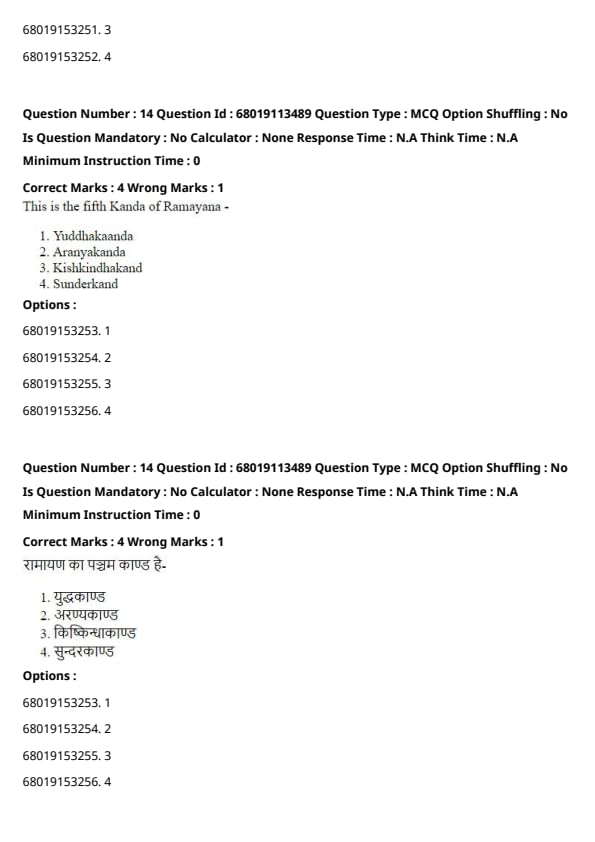






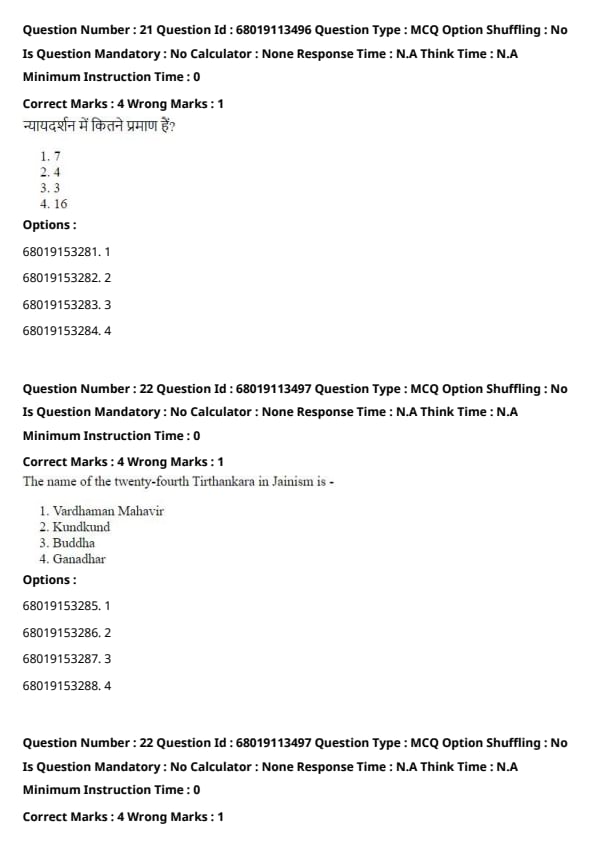




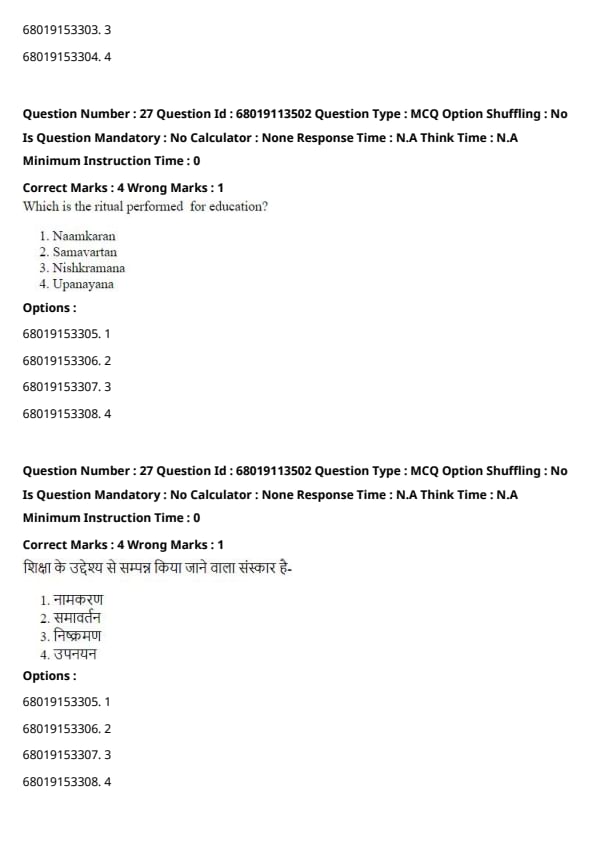
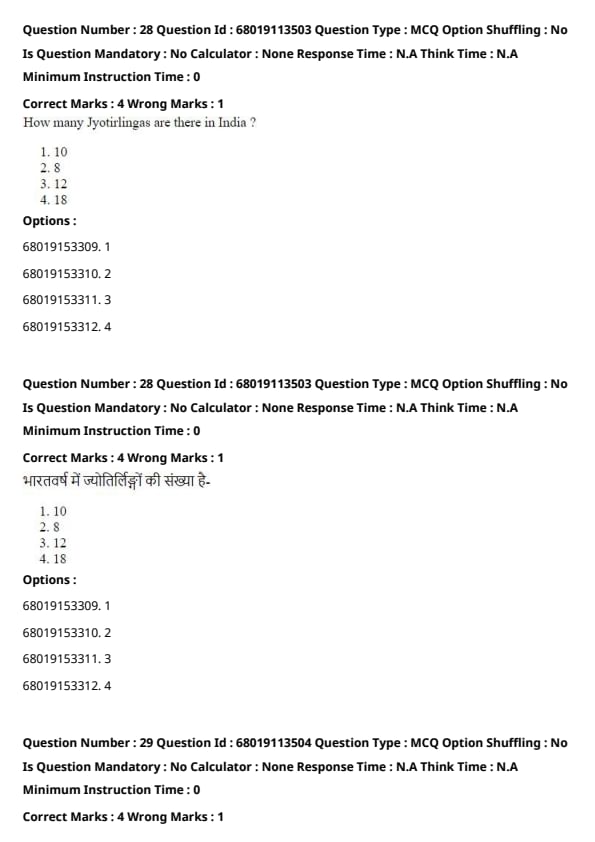
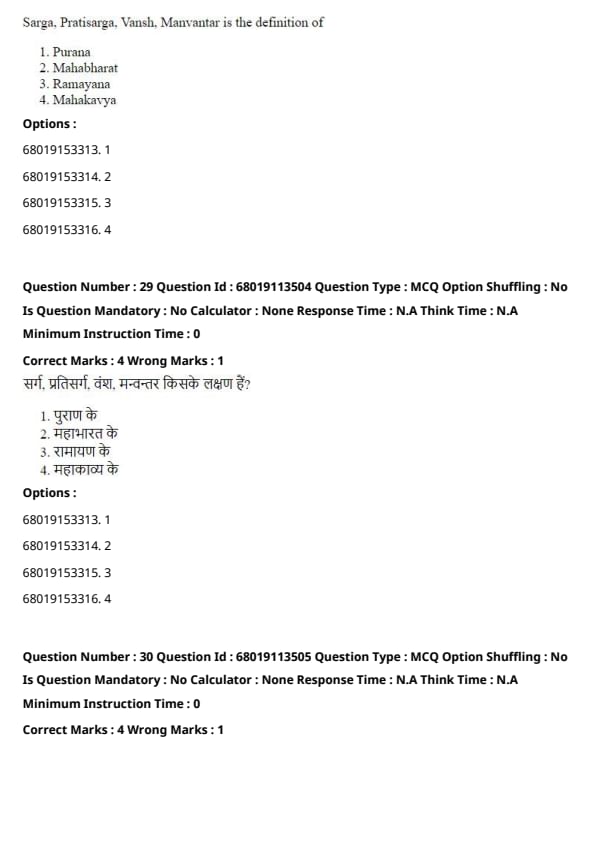


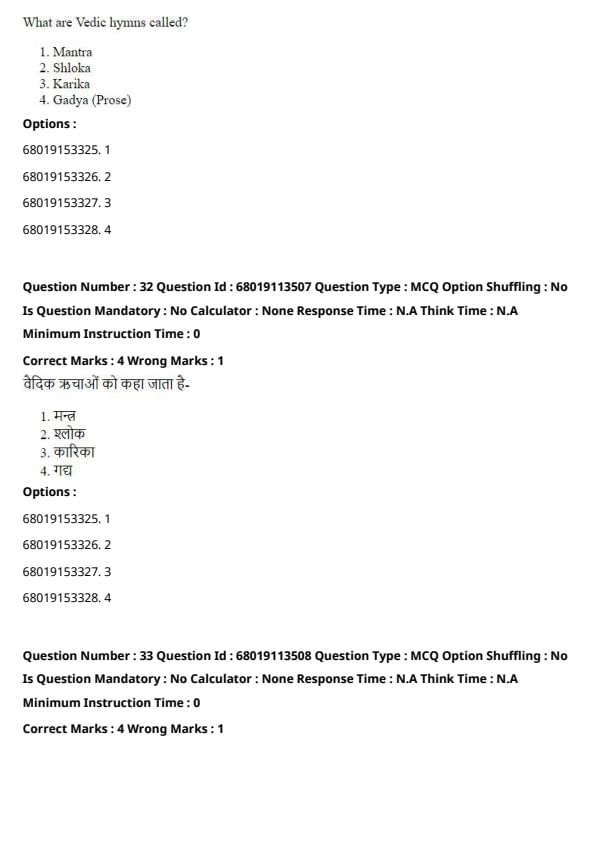


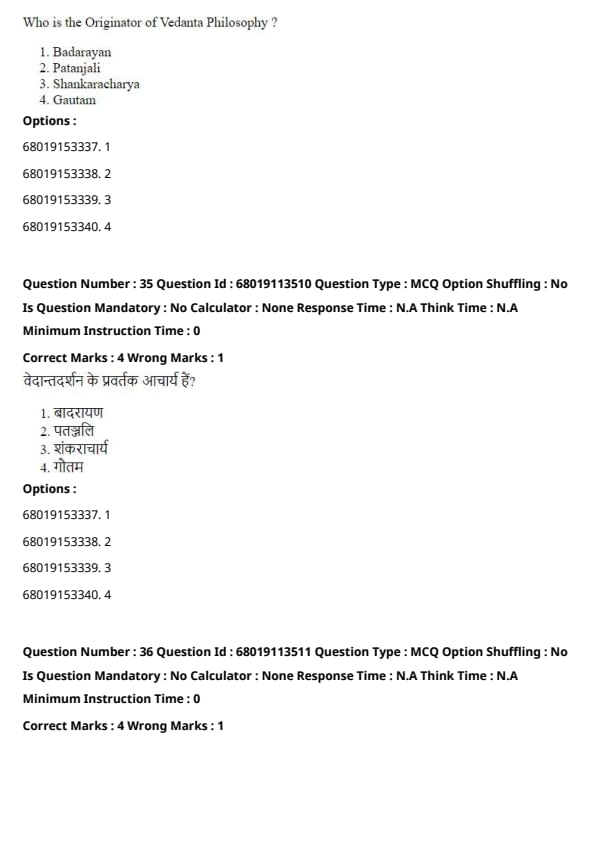
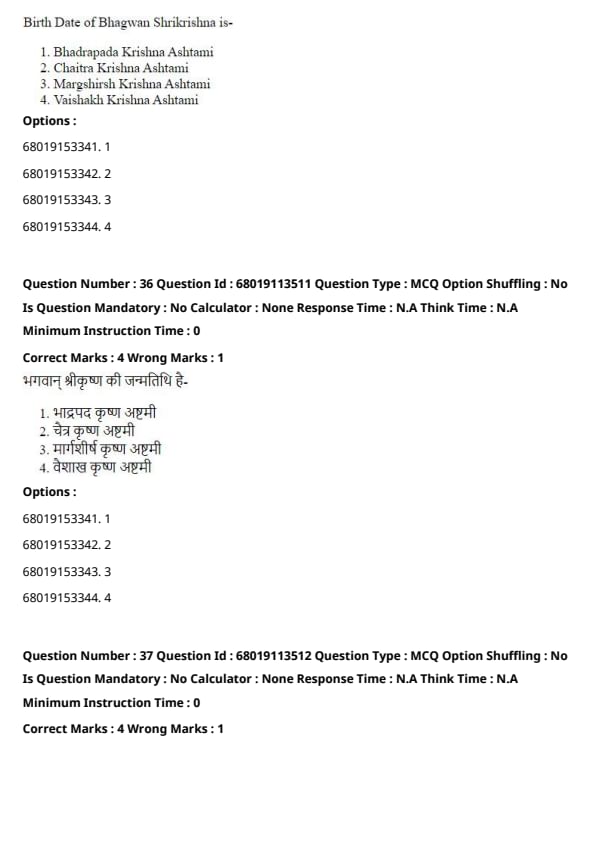



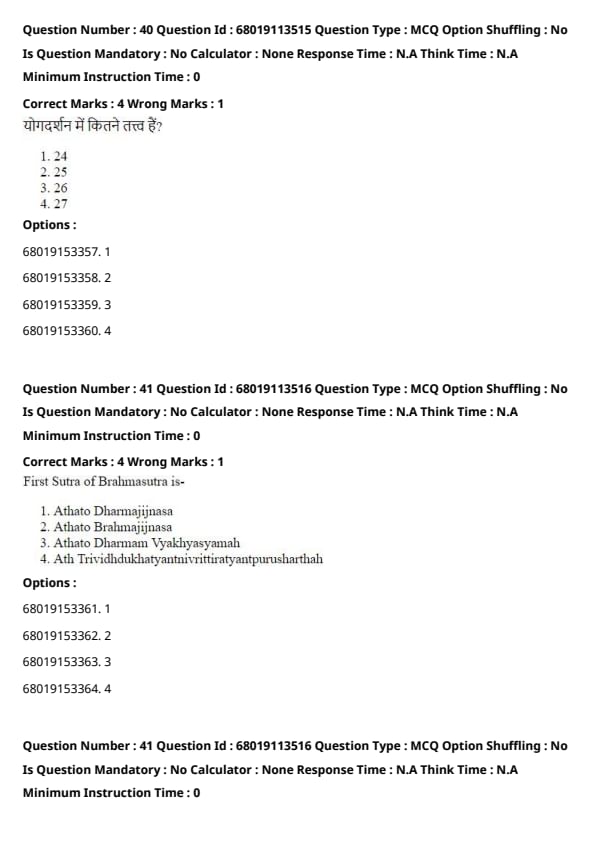

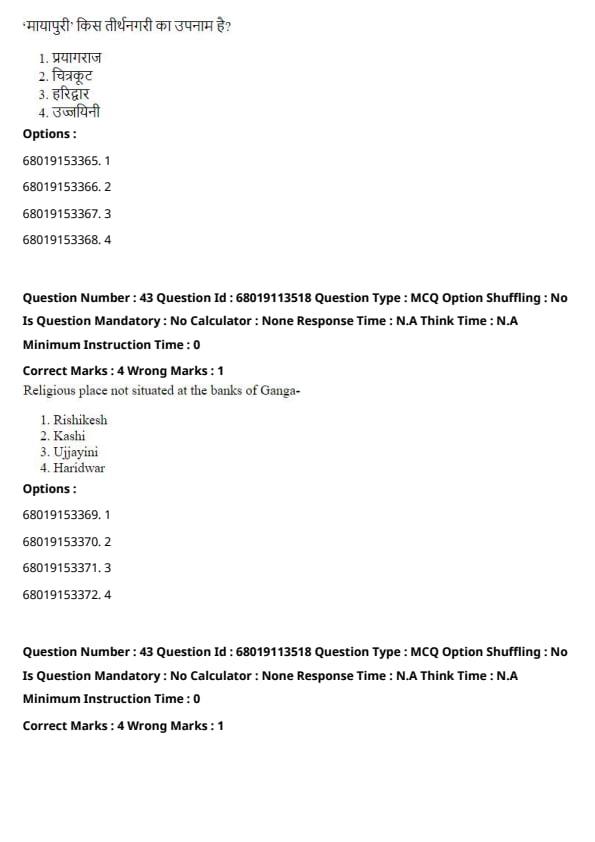


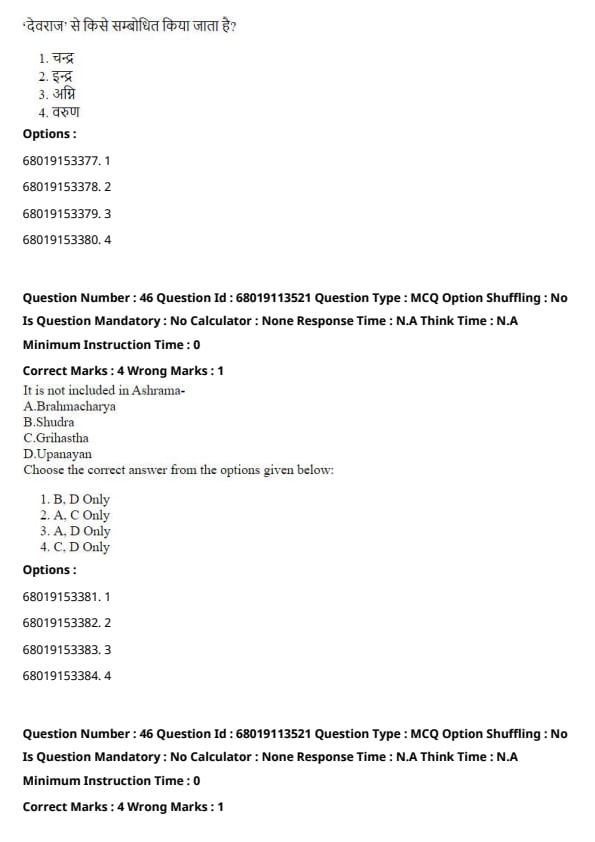
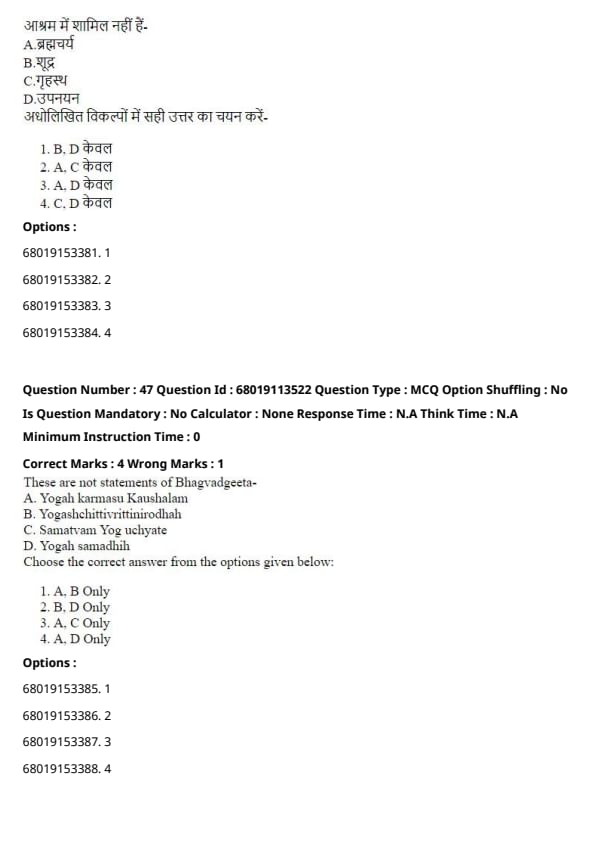


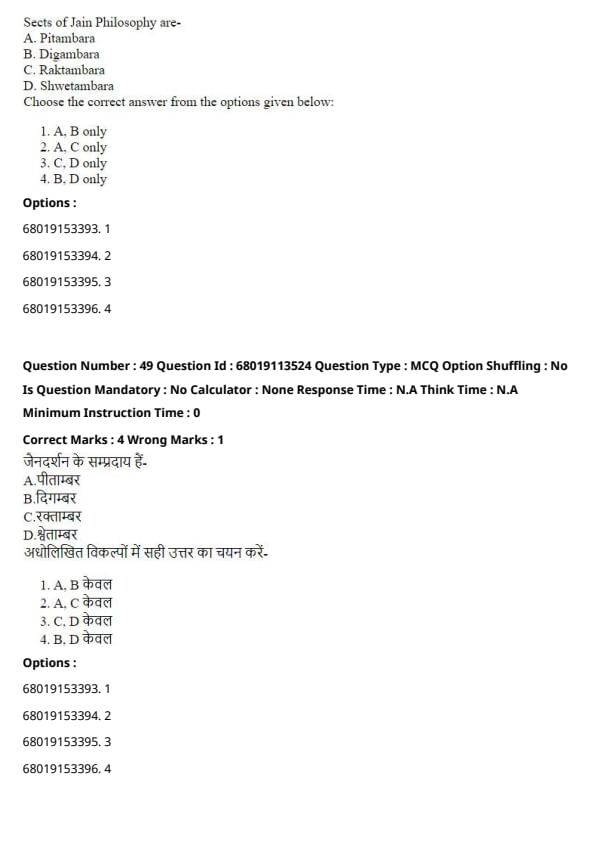
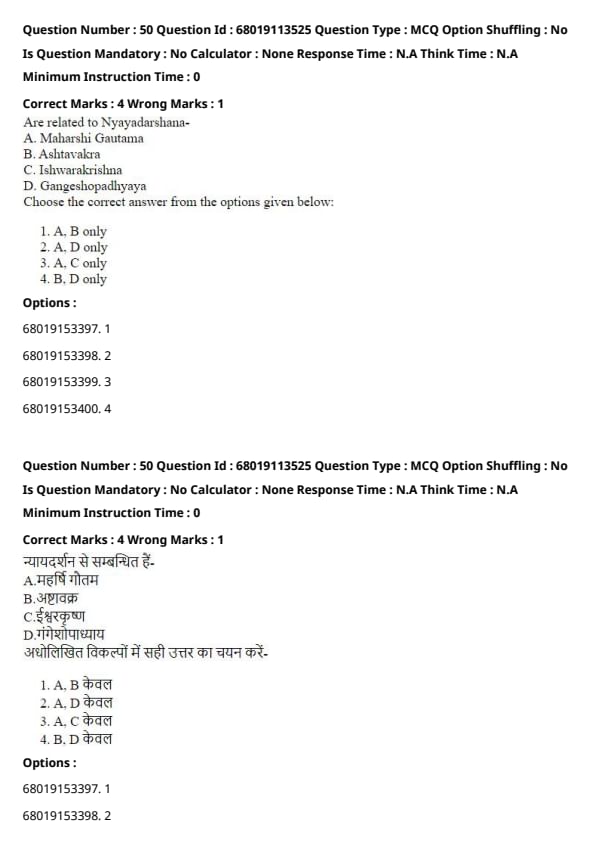

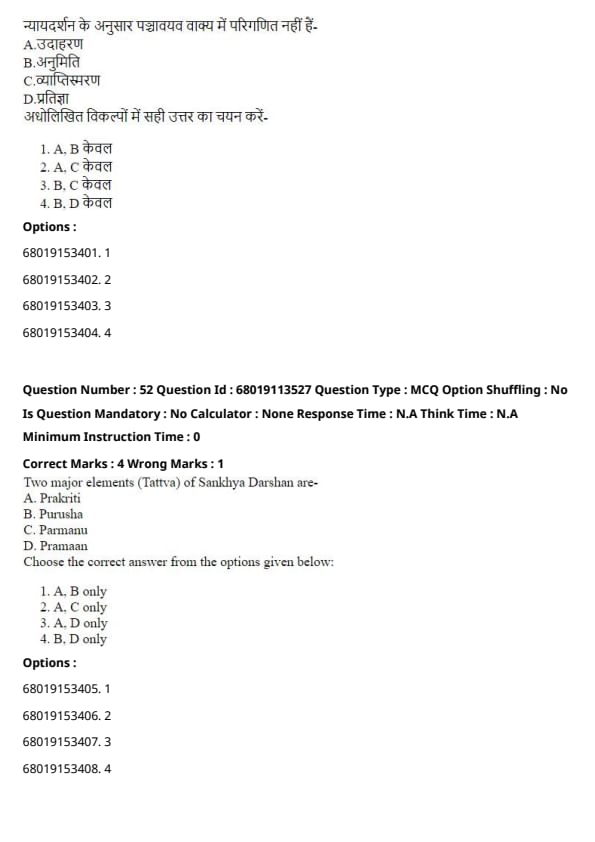
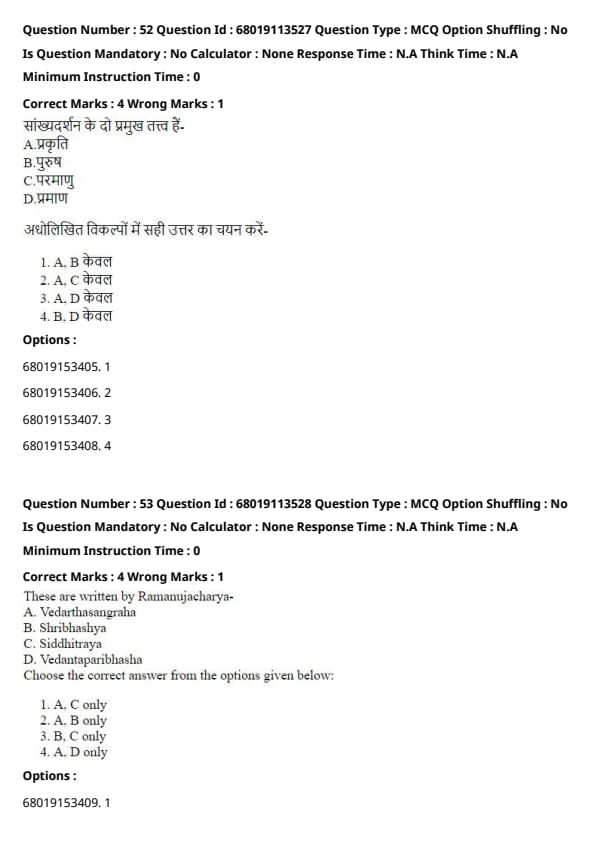





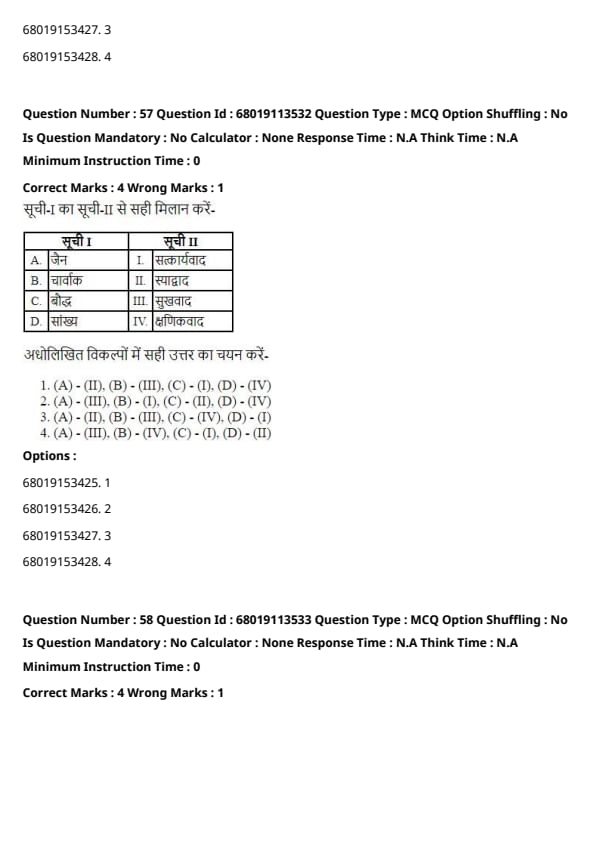




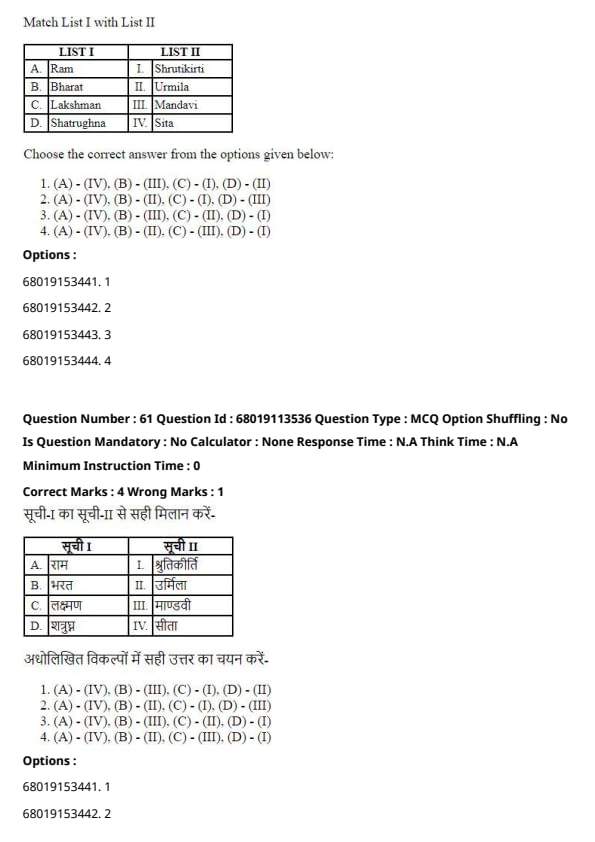
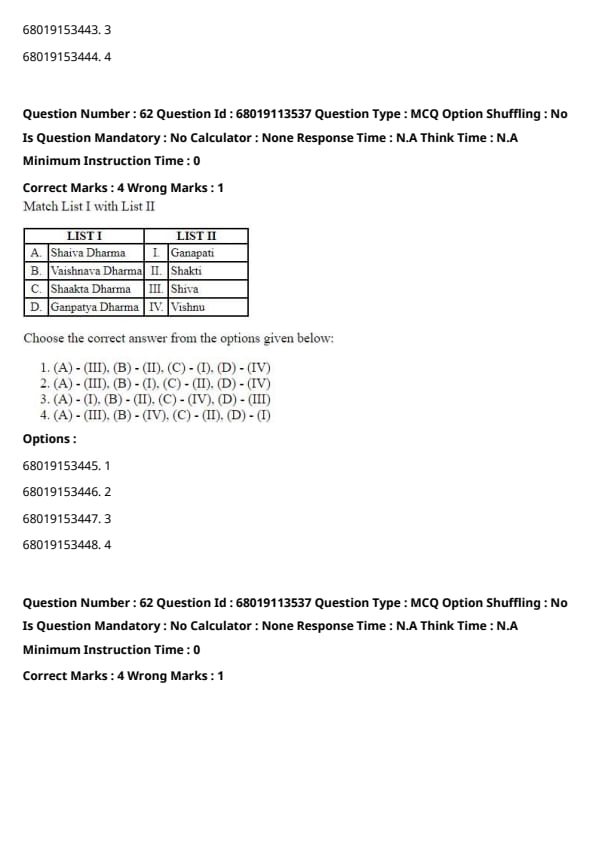
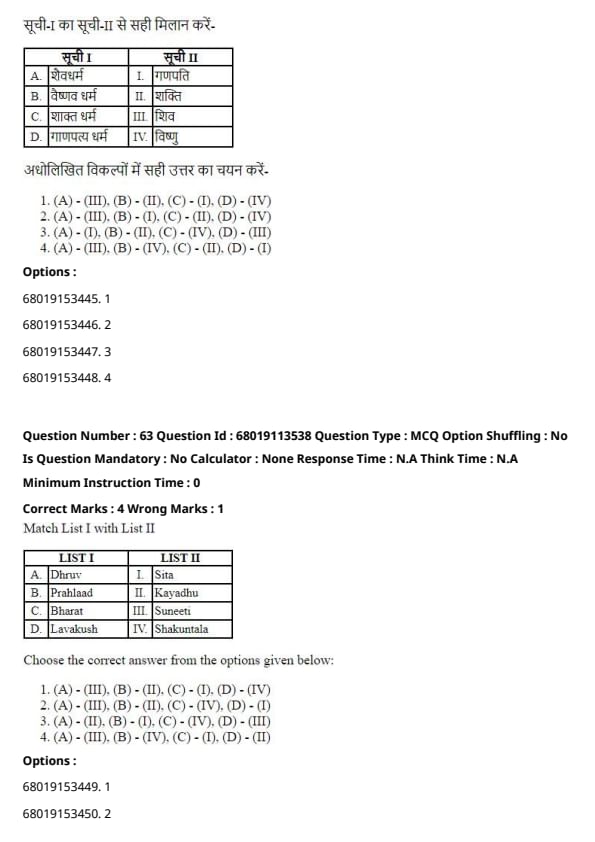
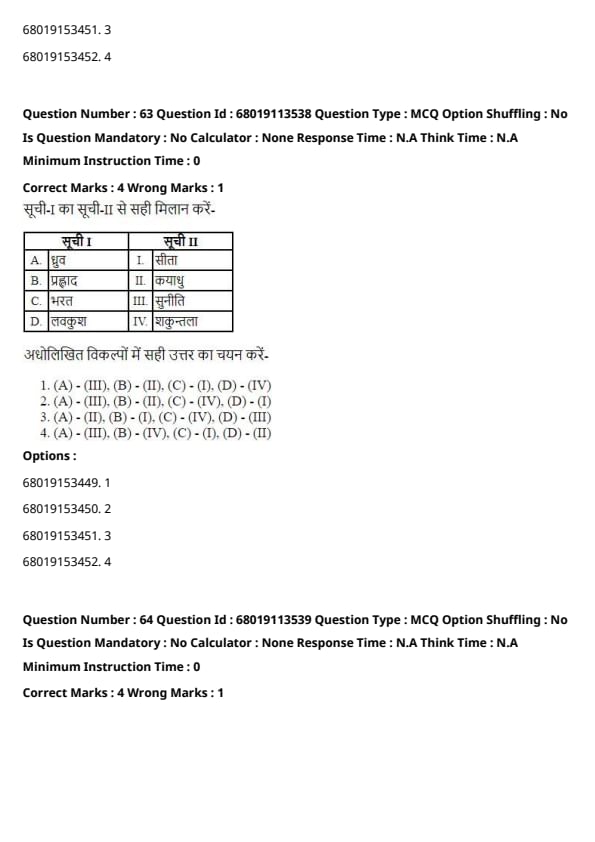

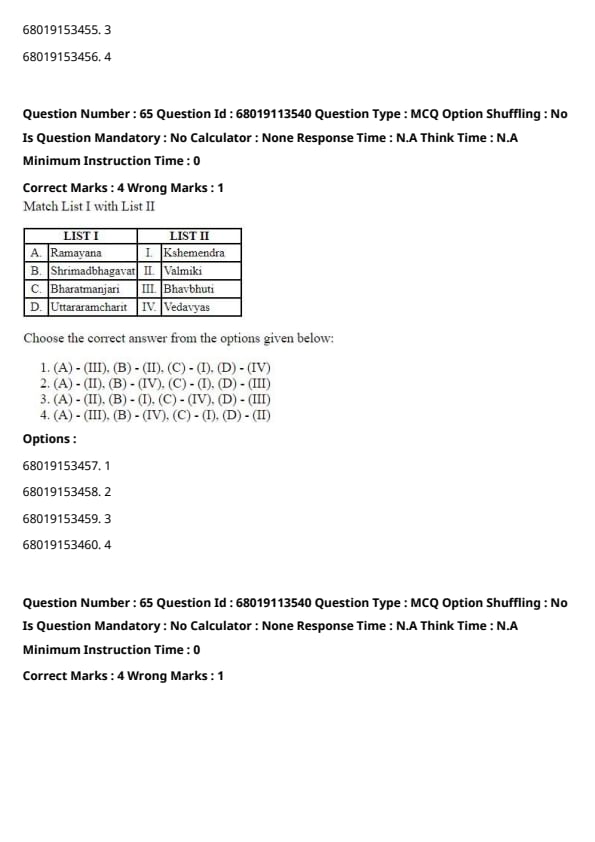
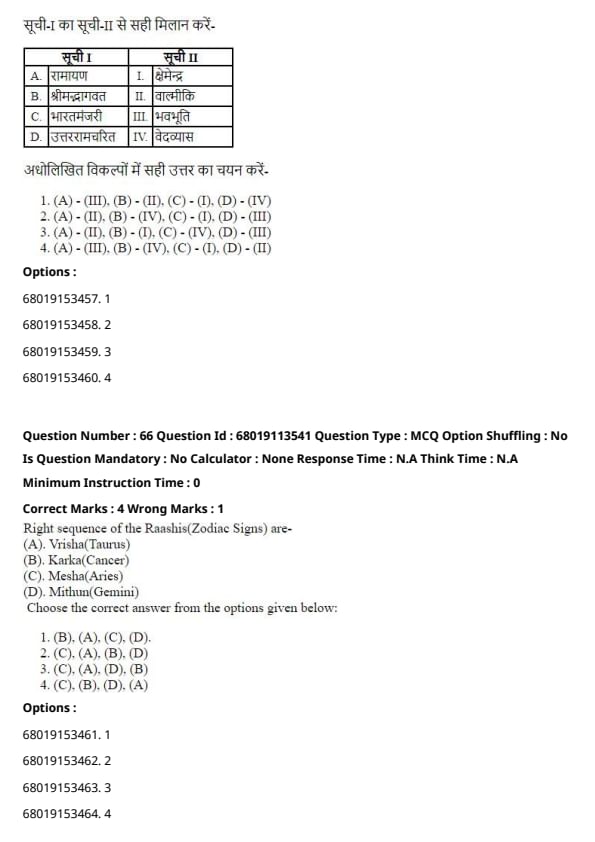

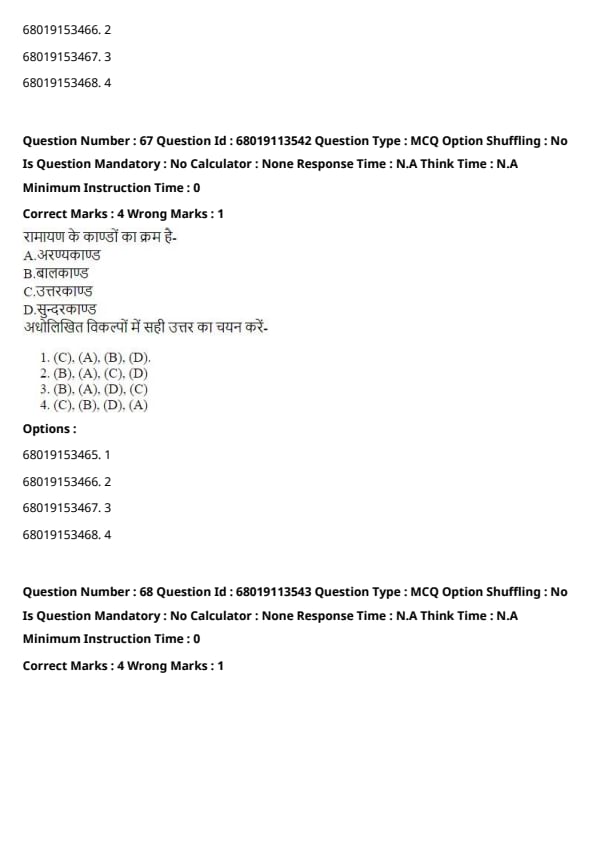








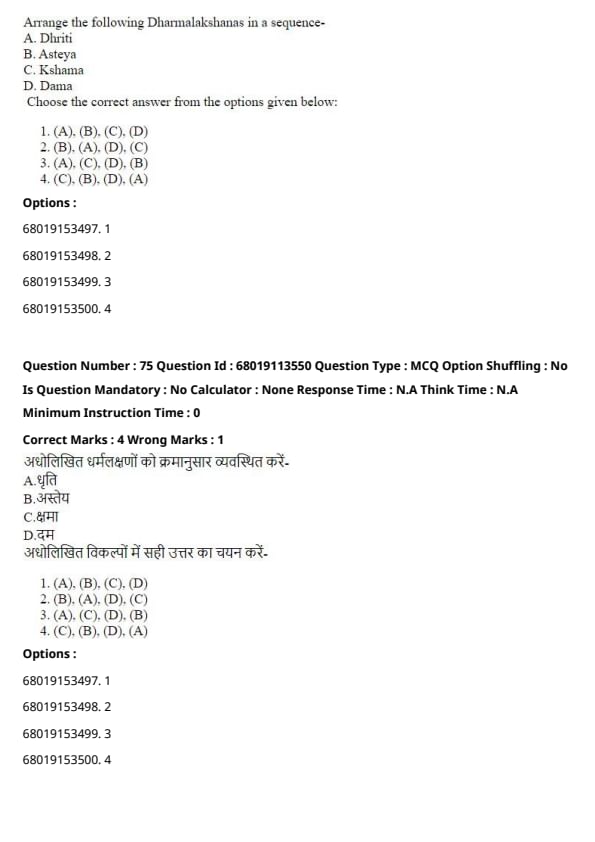



Comments